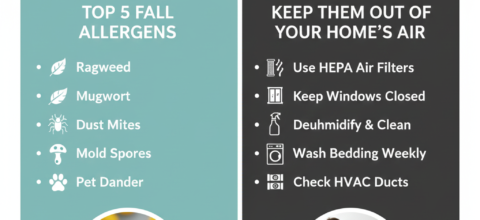How to Detect Mold in Your Home: What Every Homeowner Should Know
Mold is a concern for many homeowners, especially in areas with higher humidity levels. Beyond its unpleasant appearance on walls, ceilings, and floors, mold is a major contributor to indoor air quality issues. If left unaddressed, it can cause health problems and even compromise the structural integrity of your home.
While bathrooms and other moisture-prone spaces are prime spots for mold growth, it can also spread to less obvious areas. The challenge is that mold isn’t always visible, making early detection essential. In this guide, we’ll go over the key signs of mold, how to inspect your home, and practical steps to prevent and manage this common issue —particularly important in regions where damp conditions make homes more susceptible.
How to Detect Mold in Your Home
Mold is a fungus that can develop in nearly any part of your home, particularly in areas with high humidity and temperatures ranging from 77°F to 86°F. It spreads through microscopic airborne spores that settle on surfaces and multiply under the right conditions. While mold can take on different forms, it often appears as cottony, velvety, or feathery patches.
Spotting mold is sometimes as simple as a visual inspection. However, because it can grow in hidden areas, knowing where to look and what signs to watch for is essential. Homes in humid regions, especially those near the coast, are more prone to mold growth, making regular checks even more important.
Mold can develop in various colors, including black, green, white, and even orange. It often appears as patchy or fuzzy growth on walls, ceilings, and floors, sometimes resembling dirt or discoloration.
Common Signs of Mold Growth
A strong musty, earthy odor is one of the most reliable indicators of hidden mold, even if there are no visible signs.
Other warning signs include peeling wallpaper, warped walls, or bulging surfaces, which may suggest moisture buildup and fungal growth beneath. Mold is most commonly found in moisture-prone areas like bathrooms, basements, and crawl spaces—especially in regions with high humidity levels. Regular inspections in these areas can help catch mold problems early before they spread.
While there are thousands of mold species, one of the most concerning for homeowners is Stachybotrys chartarum, commonly referred to as “black mold” or “toxic mold.” It typically starts as small black spots but can quickly spread into large colonies. If you’ve noticed dark patches in shower grout lines, high on ceilings, or around air vents, it could be a sign of black mold.
This type of mold is particularly hazardous because it produces mycotoxins—harmful compounds that pose serious health risks, especially for individuals with respiratory conditions, weakened immune systems, or allergies. Prolonged exposure to mold spores can lead to a range of symptoms, including:
- Headaches
- Wheezing
- Coughing
- Shortness of breath
- Nasal and sinus congestion
- Runny nose
- Frequent sneezing
- Throat irritation
- Eye irritation
- Skin rashes
- Chronic fatigue
If you suspect black mold in your home, addressing it quickly is crucial to protecting both your health and indoor air quality.
How to Check for Mold in Your Home: Real-Life Cases
With over ten years in the industry, we’ve seen firsthand how unpredictable mold can be. It often develops in unexpected places, making detection challenging for homeowners. To highlight just how sneaky mold growth can be, we’re sharing real cases from customers who have faced this issue—and how they discovered it.
Case 1: Hidden Mold in a 40-Year-Old Home
In Toms River, NJ, an elderly couple noticed a persistent musty odor and mold growth on their clothing. Despite their housekeeper’s thorough cleaning efforts and a handyman’s attempt to clean the AC unit, the issue persisted. Concerned about their health, they stopped using their HVAC system and sought professional assistance. Following a recommendation from NADCA, they contacted our team for expert HVAC cleaning and mold remediation. Our thorough approach identified and eliminated the mold at its source, restoring their home’s air quality and providing them with a healthier living environment.
Case 2: Unidentified Mold Odor in an Apartment
After moving into his new apartment in Trenton, NJ, Adam immediately detected a strong mold-like smell but couldn’t determine its source. The persistent odor, combined with the health effects of inhaling airborne mold spores, made staying indoors unbearable. Seeking a solution, he turned to our specialized mold treatment for ventilation systems. Our team conducted a detailed inspection, pinpointed the problem, and treated the affected areas, making Adam’s apartment safe and mold-free.
Where to Start When Checking for Mold in Your Home
Mold thrives in damp, dark, and poorly ventilated areas, making certain parts of your home more susceptible. If you live in a humid region like Toms River, NJ, or Trenton, NJ, regular inspections are essential to prevent mold from spreading unnoticed. Here are the key areas to check:
- Bathrooms: Moisture buildup makes bathrooms a prime spot for mold growth. Inspect shower curtains, tubs, tile grout, and areas around sinks and toilets. Don’t forget to check under bath mats and inside cabinets where dampness can linger.
- Basements and Attics: These areas often have poor ventilation, making them ideal breeding grounds for mold. Musty odors can be a warning sign, so examine walls, ceilings, and floors. Stored items, especially cardboard boxes, can also harbor mold.
- Kitchens: Running water and steam create the perfect conditions for mold. Inspect areas around the sink, behind appliances like dishwashers and refrigerators, and inside cabinets. Pay attention to any damp surfaces or condensation.
- HVAC and Ventilation Systems: Mold spores can spread through your home via your heating and cooling system. Check air ducts, air filters, and the HVAC unit itself. If you notice an earthy or musty smell coming from your vents, professional cleaning may be necessary.
- Windows: Look for black or greenish spots around the edges and corners of window frames. Mold on the window sill may signal leaks due to improper sealing, allowing moisture to accumulate.
- Drywall: If your home has experienced water damage, mold may be lurking behind the drywall. Signs include peeling paint, moist or bubbled wallpaper, and a persistent musty odor.
- Bedrooms: While bedrooms are less prone to mold growth, it’s still possible, especially in areas with poor air circulation. Check closets, windows, mattresses, radiators, and vents for any mold buildup.
- Flood-Damaged Areas: If any room in your home has been affected by flooding, inspect carpets, rugs, and upholstered furniture that may have absorbed moisture. If your roof has leaked, mold may develop on or behind ceiling panels, sometimes remaining hidden from view.
Regular inspections and prompt action can help keep your home mold-free, protecting both your health and indoor air quality.
How to Test Your Home for Mold
Mold is often visible, but if you notice a musty odor or allergy symptoms, testing may be necessary. Follow these steps to check for hidden mold:
- Get a Mold Testing Kit – Available online or at hardware stores.
- Prepare the Area – Close doors and windows for 24 hours before testing.
- Set Up the Petri Dish – Follow the kit instructions, place the dish on a surface, and seal it.
- Wait for Growth – Leave the dish undisturbed for 48 hours. Extend to five days if needed.
- Check Results – If mold appears, send the sample for lab analysis.
For a thorough inspection, professional testing provides accurate results and a targeted solution.
How to Remove Mold from Your Home
Once you’ve confirmed mold growth, the next step is removal. The method depends on the surface type. Non-porous materials like tile, glass, and metal can be cleaned with household products or diluted bleach solutions. Porous materials like drywall, wood, and upholstery may require more intensive treatment—or even replacement.
Steps for Mold Removal
- Eliminate Moisture Sources – Use dehumidifiers and fans to dry affected areas completely. Address any leaks or drainage issues to prevent future growth.
- Seal Off the Area – Turn off HVAC systems to prevent spore circulation. Close doors, tape off vents, and seal gaps around windows and doorways.
- Use Protective Gear – Wear old clothing, gloves, safety goggles, and a respirator to protect yourself from inhaling mold spores and volatile organic compounds (VOCs).
- Prepare a Cleaning Solution – Mix one cup of bleach with one gallon of water. Follow product instructions for surface-specific cleaning.
- Scrub and Wipe – Use a scrub brush for stubborn mold patches, then wipe surfaces clean with a cloth.
- Dry the Area Completely – Open windows and use fans to speed up drying time. Moisture control is key to preventing mold from returning.
- Apply an Antimicrobial Spray – Use an antimicrobial treatment or fogger to prevent future mold growth. These products are widely available online or at home improvement stores.
For severe mold infestations, or if household members have respiratory conditions, professional mold remediation is the safest option.
How to Prevent Mold Growth
Prevent mold by managing moisture:
- Fix Leaks Quickly – Address plumbing, roof, and window leaks.
- Improve Ventilation – Use exhaust fans in kitchens and bathrooms.
- Control Humidity – Maintain indoor levels between 30-50%.
- Dry Water Damage Fast – Clean and dry within 24-48 hours.
- Use Mold-Resistant Materials – Opt for treated drywall and paints.
Regular maintenance reduces the risk of mold, keeping your home safe and air quality high.
Conclusion
Mold is a persistent issue that can affect any home or business, creating stress and potential health risks. While prevention is the best defense, keeping every area mold-free can be challenging. If you suspect mold growth, taking quick action through inspection and testing is essential.
In this guide, we’ve outlined effective ways to detect, remove, and prevent mold. By following these steps, you can safeguard your health, protect your property, and improve indoor air quality. However, if mold concerns persist, professional services can provide a thorough and lasting solution.
Amazon Air Duct Cleaning specializes in mold inspection, air duct cleaning, and indoor air quality improvement. With a skilled team dedicated to eliminating mold at its source, we help create a cleaner, healthier home. Call us today at (800) 482-8224 to schedule an inspection and take the first step toward a mold-free environment!









